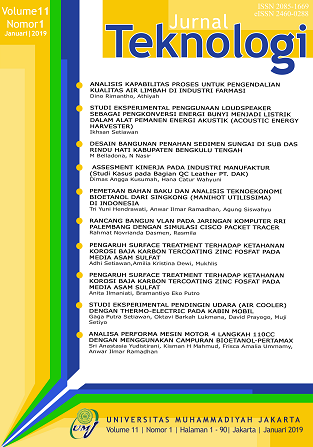ANALISIS KAPABILITAS PROSES UNTUK PENGENDALIAN KUALITAS AIR LIMBAH DI INDUSTRI FARMASI
Isi Artikel Utama
Abstrak
Unduhan
Rincian Artikel
COPYRIGHT POLICY
The author(s) of an article published in the Jurnal Teknologi retains ownership of the intellectual property rights in work (s).
PUBLISHING RIGHTS
The author(s) of an article published in the Jurnal Teknologi have unrestricted publication rights. The authors give the Jurnal Teknologi the right to publish the article and designate the Faculty of Engineering Universitas Muhammadiyah Jakarta Publishing as the original publisher of the article.
LICENSING POLICY
Journal of Mechanical Engineering and Sciences is an open-access journal that follows the Creative Commons Non-Commercial 4.0 International License (CC BY-NC 4.0), which states that:

Under this license, the reusers must give appropriate credit, provide a link to the license, and indicate if changes were made. Users may do so in any reasonable manner, but not in any way that suggests the licensor endorses users or their use.
Please take the time to read the whole license agreement (https://creativecommons.org/licenses/by-nc/4.0/). As long as reusers follow the license conditions, the owner cannot withdraw these freedoms. The following components are included under this license:
 Attribution: Users must provide appropriate attribution, including a link to the license, and indicate whether or not they made any modifications. Users are free to do so reasonably, but not in a manner that indicates the licensee approves of their usage.
Attribution: Users must provide appropriate attribution, including a link to the license, and indicate whether or not they made any modifications. Users are free to do so reasonably, but not in a manner that indicates the licensee approves of their usage.
 NonCommercial: Users may not use the material for commercial purposes.
NonCommercial: Users may not use the material for commercial purposes.
Referensi
Abou-Elela S. I. and Zaher, F., 1998.Pollution prevention in oil and soap industry” Case study, Wat.Sci.Tec.,Vol.38, pp.139-144.
Angelakis AN. and Snyder SA. 2015. Wastewater Treatment and Reuse: Past, Present, and Future, Water, 7, 4887-4895; doi:10.3390/w7094887
Breyfogle, F.W, 2003. Implementation Six Sigma, Smart Solutions Using Statistical Methods, John Willey & Sons, Inc. New Jersey.
Cunningham, V.L. Binks, S.P. Olson, M.J. 2009. Human health risk assessment from the presence of human pharmaceuticals in the aquatic environment. Regul. Toxicol. Pharmacol. 53, 39–45.
Gaspersz, V., 2002. Pedoman Implementasi Program Six Sigma Terintegrasi dengan ISO 9001:2000, MBNQA, dan HACCP, PT. Gramedia Pustaka Utama, Jakarta.
Hollender, J. Singer, H. McArdell, C.S. 2008. Polar Organic Micropollutants in the Water Cycle. In Dangerous Pollutants (Xenobiotics) in Urban Water Cycle; Hlavinek, P., Bonacci, O., Marsalek, J., Mahrikova, I., Eds.; Springer: Berlin, Germany, pp. 103–116.
Paranychianakis N.V. Salgot M. Snyder S.A. Angelakis Α.Ν. 2015. Quality Criteria for Recycled Wastewater Effluent in EU-Countries: Need for a Uniform Approach. Crit. Rev. Environ. Sci. Technol., 45, 1409–1468.
Sari A.M., Setiawan E., Ali D., 2012. Biokuagulan dari limbah kulit udang untuk penjernihan air limbah perkotaan, Jurnal Teknologi Vol. 4. No. 1., 19 - 46
Schwarzenbach, R.P. Escher, B.I. Fenner, K. Hofstetter, T.B. Johnson, C.A. von Gunten, U. Wehrli, B. 2006. The Challenge of Micropollutants in Aquatic Systems. Science, 313, 1072–1077.
Sim W.J., Lee J.W., Oh J.E., 2010. “Occurrence and fate of pharmaceuticals in wastewater treatment plants and rivers in Korea”, Environmental pollution 158, pp 1938-1947.
Stackelberg P. E., Furlong E. T., Meyer M. T., Zaugg S. D., Henderson A., Reissman D. B., 2004. “Persistence of pharmaceutical compounds and other organic wastewater contaminants in a conventional drinking water treatment plant”, Journal Science of the total environment, 329, pp 99-113.
Touraud, E. Roig, B. Sumpter, J.P. Coetsier, C. 2011. Drug residues and endocrine disruptors in drinking water: Risk for humans? Int. J. Hyg. Environ. Health. 214, 437–441.

